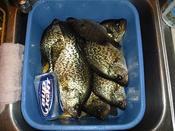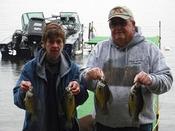 If your like me, this time of the year I start getting ready for ice out and chasing my favorite pan fish the crappie. One of the most sought after species in the country. Crappie is the third most sought after fish overall, only ranking behind bass and catfish and are sought after both shore and boat anglers alike. crappie have been distributed throughout the lower 48 states and Canada. Everyone that fishes for crappie knows there is two species of crappie, the scientific terms are Pomoxis nigromaculatus-black crappie and Pomoxis annularis -White crappie. Like other members of the sunfish family, crappie are nest builders, similar to bluegills that they have a tendency to nest in large beds. This occurs when the water temperature reaches 60 to 68 degrees. Fact is, crappie can lay 20,000 eggs will hatch in 3 to 7 days, all of the hatchlings will not make it to adult stage, these hatchlings will be food for other fish like bluegill, perch and bass. Many anglers have difficult time distinguishing the black crappie from the white. The best way I have found is to count the dorsal spines. Black crappie has seven to eight dorsal spines with black blotches where white crappie have six dorsal spines with black vertical bars. The world record black crappie was caught on the Vermilion River,MN in 1940 and weighed 5lb and the world record white crappie was caught on Enid Lake, MS in 1957 and weighed 5lb. 3oz.
If your like me, this time of the year I start getting ready for ice out and chasing my favorite pan fish the crappie. One of the most sought after species in the country. Crappie is the third most sought after fish overall, only ranking behind bass and catfish and are sought after both shore and boat anglers alike. crappie have been distributed throughout the lower 48 states and Canada. Everyone that fishes for crappie knows there is two species of crappie, the scientific terms are Pomoxis nigromaculatus-black crappie and Pomoxis annularis -White crappie. Like other members of the sunfish family, crappie are nest builders, similar to bluegills that they have a tendency to nest in large beds. This occurs when the water temperature reaches 60 to 68 degrees. Fact is, crappie can lay 20,000 eggs will hatch in 3 to 7 days, all of the hatchlings will not make it to adult stage, these hatchlings will be food for other fish like bluegill, perch and bass. Many anglers have difficult time distinguishing the black crappie from the white. The best way I have found is to count the dorsal spines. Black crappie has seven to eight dorsal spines with black blotches where white crappie have six dorsal spines with black vertical bars. The world record black crappie was caught on the Vermilion River,MN in 1940 and weighed 5lb and the world record white crappie was caught on Enid Lake, MS in 1957 and weighed 5lb. 3oz.
Anglers chase spring crappie because they tend to move into shallow water and stack up close to shore. They are relatively easy to catch once you find them. Usually moving around in large schools- when you hook into one fish, chances are good that you are going to catch a bunch of them. Overall, finding crappie and catching a limit of slabs is at it’s best this time of year.
After ice out, head to northern portion of your favorite body of water and seek out the back bays, canals and shallow coves with dark bottoms and sheltered cover as they typically provide the best prespawn/spawn crappie areas and are the first areas to warm. Once the water starts warming Crappies will hold or stage just outside of these areas along the edges of deep weeds or timber prior to spawning, and then move into the shallows again to feed or seek out nesting sites. Working these deeper staging areas can be the ticket when the fish seemed to have shut down in their usual haunts. Large reservoirs and natural lakes have main lake crappie spawning, too. All of the fish don’t head for the bays or coves. Usually the bigger crappies will use shallow, brushy humps in reservoirs, or main lake reed beds in natural lakes, often host a portion of the spawn for the larger fish. Since the water in the main lake typically warms more slowly than in back bays or coves, the best activity there typically occurs a week or two after the shallows start producing.
 Techniques for catching crappie
Techniques for catching crappie
Many live and artificial baits work well for these prolific little feeders. Minnows are the preferred bait usually out producing all other techniques where the crappie are located. A basic cork rig, with a float, split shot, No. 4 or 6 hook and live minnow, is tough to beat. Just flip the bait out and let it settle, and then experiment with different depths until you start getting bites. Using small jigs and small spinner baits such as roadrunners, beetle spins and small tube baits work well also. Waxies and euro larvae can also be a good choice hooked on a small jig under a cork will produce crappies and other pan fish. Crappie are opportunistic feeders, depending on the season they will feed on small fish, water beetles, nymphs and small shrimp and you will need to match the hatch. Find the right size, colors & type of artificial bait that matches what they are feeding on at the right depth and you will have a great day on the water with a delicious meal to boot!
See Ya on the Water, JC

Now there’s a nice informative report!
I am ready for open water and crappies. i like to use mister twisters for early crappies and sometimes bass



Great report, and I too, as well countless other crappie fishermen are looking forward with much anticipation to spring and getting back on the water. It’s been a long and hard winter and catching some beautiful crappie on a nice sunny warm day sounds pretty good about now. Thanks again for getting the juices flowing.
sweet read….awesome fish